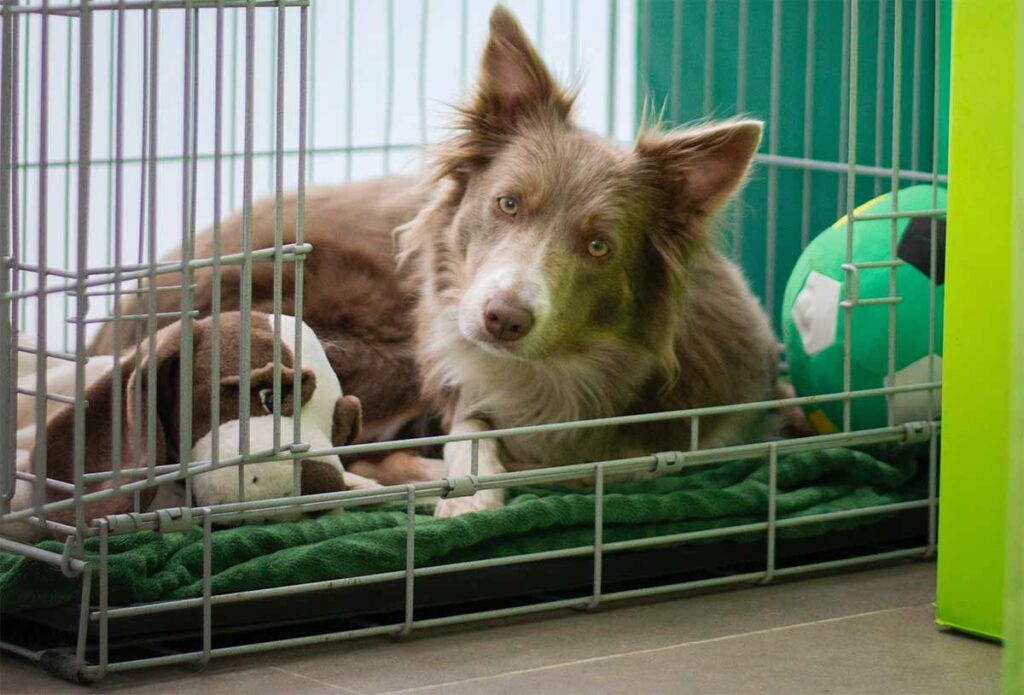
This article was updated on September 25th, 2021
Many owners worry about their dog’s health as they age; their elderly pooch appears to slow down, become less active and may seem less interested in things that once excited them. Whining or crying is one such sign that older dogs may start to exhibit and the first worry that passes through an owner’s mind is if their dog is in pain or uncomfortable. Often, older dogs also start whining in their crates or at night.
Whining or crying is a non-specific symptom – meaning that there can be many possible causes. While puppies might whine for attention or food, older dogs rarely whine for these reasons alone unless they have done so all their life. An elderly dog that has recently started whining in his crate is likely doing so because they feel uncomfortable or confused, and therefore is something that shouldn’t be ignored.
Whining is usually expressed as a high-pitched vocalisation, but it really just refers to any disconcerting noise a dog might make. Try to identify a pattern to the whining and if the frequency of whining throughout the day is changing. The more information you can provide your vet with, the more likely any treatment prescribed will be effective.
Most Common Causes for a Dog Whining or Crying in his Crate
The most common causes for a dog whining in his crate are either because he feels uncomfortable in the restricted space or because he feels anxious, confused, or needy in some way. This article will go into detail about these causes and what you can do to help.

Pain and discomfort
One of the most common reasons why your elderly dog might be whining whilst in his crate is because he can’t get comfortable. The most common causes of pain or discomfort in an elderly dog are musculoskeletal issues, such as osteoarthritis, and abdominal pain.
Crates are enclosed areas and so there isn’t always much room for a dog to lie down or stretch out. If a dog is feeling pain somewhere in his body then he will likely try to re-arrange and change position frequently to get comfortable. A crate limits the room available for movement and therefore may result in your elderly dog whining.
You might think one solution would be to get a larger crate, or not keep your dog in the crate at all. However, the whining shouldn’t be ignored and just because it can be improved by removing the crate from the equation, doesn’t mean that it shouldn’t be investigated. The two most common causes of pain in an elderly dog are osteoarthritis and abdominal pain:
Arthritis
Osteoarthritis is the most common cause of joint pain and mobility issues in senior dogs. As a dog ages, so too do their joints; grinding of the joint surfaces and a gradual deterioration of the cartilage within the joint results in uneven wear, inflammation, and pain. Other than whining, common signs of arthritis include stiffness, muscle wastage and a reluctance to exercise.
Dogs with arthritis will often struggle to get comfortable – inflammation and irregular bone growth within the joints leads to pinching and aching pains in certain positions. This might explain why your dog whines when he is confined to the crate but seems fine when out and about.
Thankfully there are some things you can do to help your dog. Making the crate more comfortable by adding pillows and cushions to ease the pressure on his joints will provide some relief.
If your dog needs to be kept in the crate most of the day then letting him out every few hours to stretch his legs may have some benefit too. Supplements such as glucosamine and chondroitin can help keep your dog’s joints lubricated and healthy, while keeping your dog from becoming overweight will prevent excessive load on the joints.
If your dog is still in discomfort then they may require regular pain relief or anti-inflammatory medication, and there are various options available. Many medications do come with side effects however, so be sure to talk to your local veterinarian to help you weight up the pros and cons. Many non-steroidal anti-inflammatories are harmful to the kidneys when used long term for example so regular blood tests should be performed to ensure you aren’t causing any adverse effects.
Abdominal pain
Abdominal pain is another possible cause for whining in the crate. When forced to lay or sit down, abdominal organs can become compressed, further exacerbating any abdominal pain that may be felt. A hunched back, tense abdominal muscles and even enlarged stomach can all indicate pain originating somewhere within the abdomen.
Abdominal pain can indicate a more serious underlying condition including cancer, liver and kidney damage or even internal bleeding. If your dog is displaying these symptoms, especially if the pain is sudden in onset, then you should take them to the vets immediately where blood tests or an ultrasound scan can be performed.
Fear and anxiety
Older dogs often become more needy and dependent on their owners, in particular when put in their crates. As they slow down they aren’t as able to do their favourite activities as they once were, even if they still want to. They will often rely on owners to help them climb to high places and to help them feel less vulnerable. For this reason, your older dog who may have once been content in his crate, may feel abandoned when left alone.
Separation anxiety can affect dogs of any age but often becomes worst as dogs become more senior. Anxious dogs may also tremble or pant and may be hypersensitive to loud noises. Be sure to rule out painful causes of whining first but if you think your elderly dog is whining due to anxiety there are some things you can do to help.
Plug-in pheromone diffusers such as Adaptil can help promote a stress-free environment, reducing separation anxiety, nervousness and fear and the symptoms associated. In more severe cases, medication such as diazepam, an anti-anxiety drug, or amitriptyline, an antidepressant, can be prescribed by your vet; all medications have side effects so these shouldn’t be used lightly and your vet can talk you through the pros and cons.
Although there is no cure to anxiety, the above solutions can reduce the symptoms associated with it.
Doggy dementia
Also known as canine cognitive dysfunction, this is a condition where an old dog’s cognitive abilities diminish over time, leaving them confused and forgetful. The crate where they may have once felt settled and at home might now seem more like an abnormal environment that confuses them. Furthermore, being confined can increase the symptoms of confusion.
Other signs of doggy dementia include aimless pacing, staring into space and losing interest in their once favourite activities. Dementia is a condition that is hard to diagnose in dogs as there are no cognitive tests they can take; it is important to rule out other neurological diseases however, such as seizures or incoordination, as these could indicate more serious brain issues.
There is no known cure to doggy dementia unfortunately, it is a slowly worsening process and the symptoms will likely get more dramatic over time as functional neurons within the brain decrease in number. In most cases dementia effects owners more than our pets themselves; they are none the wiser and as long as your dog still has a good quality of life, it may not be too much to worry about. Consider taking them out of the crate if it seems to be a trigger for their whining.
Various diets exist that claim to help with doggy dementia, but these have shown limited results. A medication known as propentofylline is available which aims to increase blood flow to the brain, but the effects from dog to dog vary.
In some cases, the fix for whining or crying in the crate may be easy – don’t put your dog in its crate. But many dogs will still continue to whine whether the cause be pain, anxiety or confusion.
The first step is to take your dog the vet for a general check-up. Its important to rule out whining because of abdominal pain as this could represent the most immediately life-threatening cause. It’s also possible that a number of causes are contributing to an animal whining so addressing one may not stop the symptoms.
Disclaimer: This website's content is not a substitute for veterinary care. Always consult with your veterinarian for healthcare decisions. Read More.


I’ve been dealing with the same issue with my older dog, and it can be really tough to hear them whine. I found that gradually getting them used to the crate again helped a lot, along with making it a more comfortable space with their favorite blanket. It’s comforting to know I’m not alone in this!
Thank you for this post! I’ve noticed my dog whining in his crate lately, and it’s been concerning. Your suggestions about checking for discomfort and ensuring he’s comfortable made a lot of sense. I appreciate the tips on gradually acclimating him to the crate again. I’ll definitely try to implement some of these strategies!
I can totally relate to this! My dog started whining in his crate too, and it was stressful to figure out the cause. After realizing he might just want a little more comfort and companionship, I tried adding a worn t-shirt inside with him and that seemed to help a lot. I would love to hear more tips from others who have faced this issue!
I completely understand what you’re going through. My old dog started whining too, and it was so hard to hear. I found that adjusting his routine and giving him more frequent breaks helped a lot. It’s tough, but patience and understanding go a long way. Hope you find a solution that works for you both!
Thank you for this helpful post! My old dog recently started whining in his crate, and I was worried it was a sign of something more serious. The tips on checking his comfort and providing him with a calming environment were great. I’ll definitely try some of these suggestions to see if it helps!
I can totally relate to this! My dog started whining in his crate too, and it was heartbreaking. I found that spending a bit more time with him before bed helped, along with some comforting items in the crate. It’s tough seeing them upset, but I hope you find a solution that works for both you and your pup!
I’ve experienced this with my old dog as well. It can be tough to hear them whine, especially if they’re used to their crate. I’ve found that sometimes just touching or talking to them softly can help reassure them. Also, making sure they have a cozy blanket and maybe even a favorite toy in there made a big difference for us. Thanks for sharing this!
I totally relate to your experience! My dog started whining in his crate too, and it was really concerning. I found that reinforcing positive crate time with treats and toys helped a lot. It took some patience, but now he seems much happier! Thanks for sharing your tips!
I totally relate to this! My dog started whining too, and it was tough to figure out what to do. Thanks for sharing tips on comforting them and understanding their needs. It really helps to know I’m not alone in dealing with this!